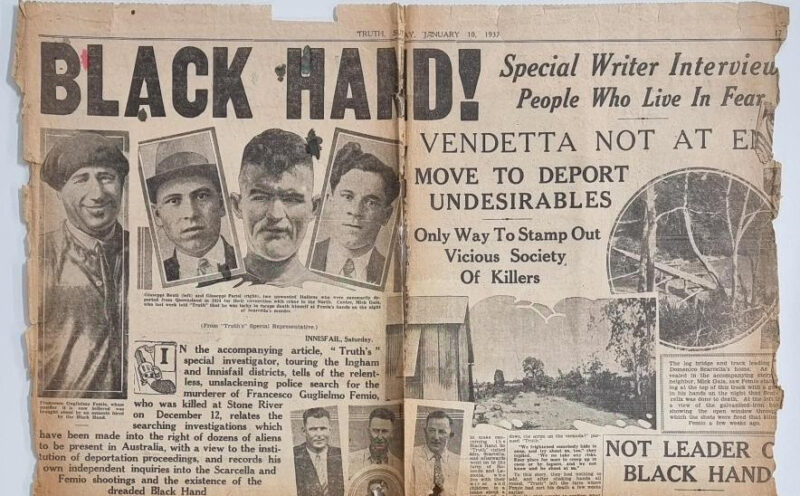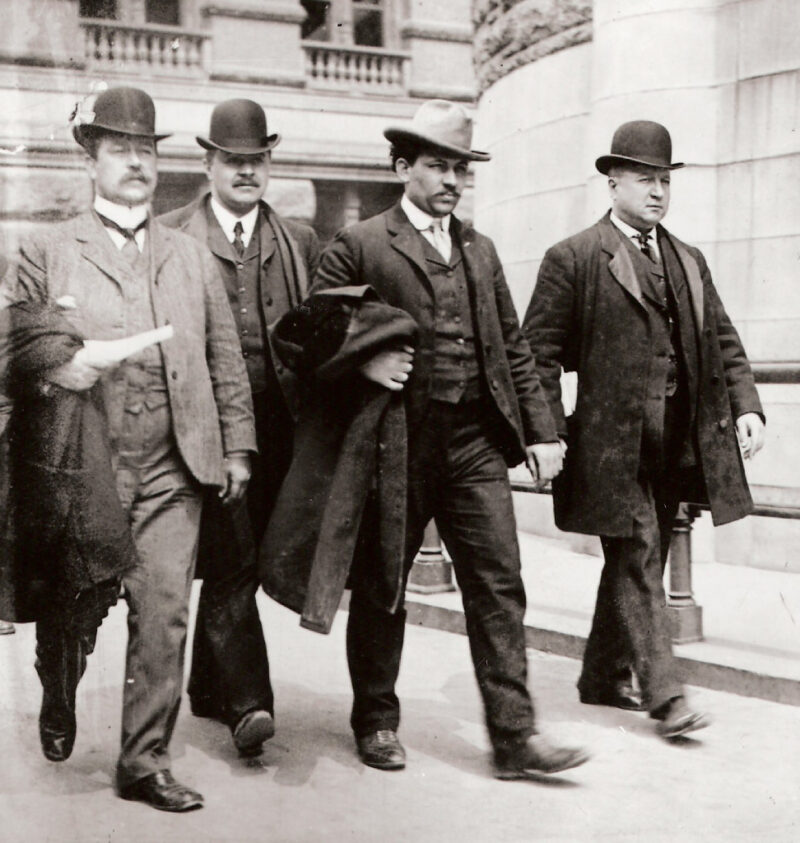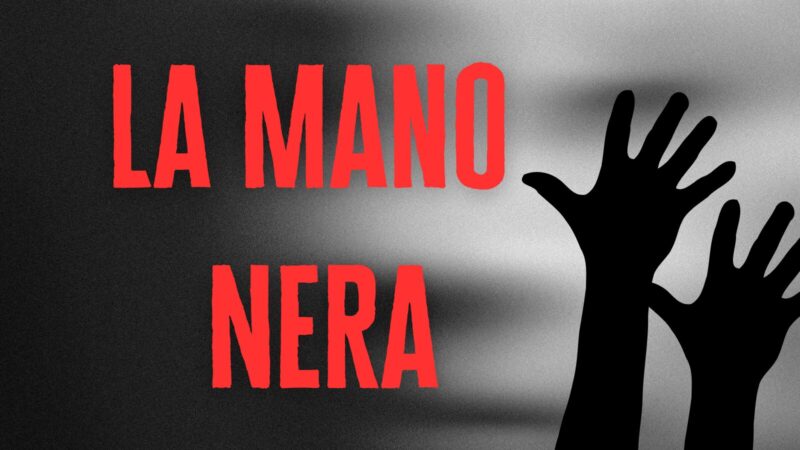The Black Hand Mafia, also known as “La Mano Nera,” terrorized Italian-American communities in the late 19th and early 20th centuries through extortion and violence.
Originating in Southern Italy, this criminal organization used fear to control and exploit immigrants. Its members operated with ruthless efficiency, sending threats marked with black handprints to coerce money from their victims.
Despite law enforcement efforts to dismantle the group, the Black Hand’s legacy left a lasting impact on the perception and treatment of Italian immigrants in the United States.
Early Criminal Activities
In its early days, the Black Hand engaged in various criminal activities, including theft, smuggling, and murder. These activities were directed at wealthy landowners and officials who refused to comply with the organization’s demands. The Black Hand operated under a strict code of silence, known as omertà, which helped maintain secrecy and control.
Migration to America
In the late 19th and early 20th centuries, many Italians immigrated to the United States, bringing members of the Black Hand with them. Cities like New York, Chicago, and New Orleans became new centers for the organization’s activities. The Black Hand continued their extortion and criminal activities in these urban areas, targeting fellow immigrants.
Extortion Tactics and Methods
The Black Hand was notorious for its brutal extortion tactics. Members often sent threatening letters to their victims, marked with a black handprint. These letters demanded money and threatened violence or death if the demands were not met. The fear instilled by these letters ensured that many victims complied without reporting the extortion to authorities.
Role of Fear
Fear was a crucial tool for the Black Hand. Victims who received black hand letters often lived in terror. Those who refused to pay faced violent retribution, including beatings, arson, and murder. This pervasive fear ensured that extortion demands were often met without resistance.
Community Impact
The impact of the Black Hand’s extortion was profound, particularly in Italian-American communities. Business owners and wealthy individuals were prime targets, leading to widespread fear and mistrust. The constant threat of violence made it difficult for victims to seek help from law enforcement, further entrenching the organization’s power.
Expansion to the United States

With the influx of Italian immigrants to the United States, the Black Hand found fertile ground for expanding its operations. Major cities like New York, Chicago, and New Orleans became hubs for the organization’s activities. The dense immigrant populations in these cities provided both cover and opportunity for the Black Hand to thrive.
New York Operations
In New York, the Black Hand’s activities were concentrated in areas with large Italian communities, such as Manhattan’s Little Italy. Extortion, kidnappings, and bombings became common tactics used to intimidate and control their targets. Notable figures like Ignazio Lupo played significant roles in the New York operations.
Chicago Operations
Chicago was another key location for the Black Hand. The city’s Italian neighborhoods were plagued by extortion and violence. The Chicago Police Department formed specialized units, such as the Black Hand Squad, to combat these crimes. Despite these efforts, the Black Hand maintained a strong presence in the city, contributing to the broader landscape of organized crime in Chicago.
Notable Figures and Leaders

The Black Hand Mafia had several notorious leaders who played crucial roles in its operations. Ignazio Lupo, known as “Lupo the Wolf,” was one of the most infamous figures in the New York chapter. He was involved in numerous extortion schemes and was known for his ruthless methods. Another key figure was Giuseppe Morello, who worked closely with Lupo to expand the Black Hand’s influence in New York.
Also, check out some non-Italian members of the American mafia.
Ignazio Lupo
Lupo’s leadership was marked by his ability to instill fear and control over the Italian immigrant community. He was eventually apprehended and imprisoned, but his activities left a lasting impact on the organization and its methods.
Giuseppe Morello
Morello was instrumental in organizing and executing extortion schemes. His influence extended beyond New York, impacting other cities where the Black Hand operated.
Law Enforcement Response
Combating the Black Hand was a significant challenge for law enforcement. The organization’s secrecy and the fear it instilled in its victims made it difficult for police to gather evidence and secure convictions. Despite these challenges, some law enforcement officers, like Joseph Petrosino of the NYPD, made notable strides in fighting the Black Hand.
Joseph Petrosino’s Efforts
Petrosino led the Italian Squad, a special unit within the NYPD tasked with tackling the Black Hand. His efforts were instrumental in apprehending several key members of the organization. Tragically, Petrosino was assassinated while on a secret mission in Sicily, highlighting the dangers faced by those opposing the Black Hand.
Specialized Units
In cities like Chicago, specialized units such as the Black Hand Squad were formed to combat the organization. These units were staffed with Italian-speaking officers who could infiltrate and gather intelligence within the Italian communities. Despite their efforts, the Black Hand’s influence remained strong due to political corruption and community fear.
Impact on Italian-American Communities
The Black Hand’s activities had a profound impact on Italian-American communities, fostering a climate of fear and mistrust. Business owners were frequent targets of extortion, leading many to comply with the demands to protect their families and livelihoods. This widespread fear also hindered cooperation with law enforcement, allowing the Black Hand to operate with relative impunity.
Community Response
The pervasive fear created by the Black Hand led many community members to avoid involving the police. This reluctance to seek help further entrenched the organization’s power, as victims preferred to pay the extortion demands rather than risk violent retribution.
Economic Impact
The constant threat of extortion also had economic repercussions, as business owners were forced to divert significant resources to pay off the Black Hand. This financial strain stifled economic growth and created an atmosphere of anxiety and uncertainty within the community.
Media and Public Perception
The media played a significant role in shaping public perception of the Black Hand. Sensationalized reports of violence and extortion fed into the fear and mistrust surrounding Italian immigrants. This negative portrayal contributed to the stereotyping of Italians as inherently criminal, further complicating their integration into American society.
Sensationalism in Reporting
Newspaper articles often exaggerated the extent of Black Hand activities, creating a sense of widespread panic. This sensationalism heightened public fear and influenced law enforcement’s approach to combating the organization.
Impact on Immigrant Identity
The association of Italian immigrants with the Black Hand had long-term effects on their identity and social standing in America. Many Italians faced discrimination and prejudice, which was exacerbated by the media’s portrayal of them as criminals.
The Role of Joseph Petrosino
Joseph Petrosino was a pioneering figure in the fight against the Black Hand. As the leader of the Italian Squad in the NYPD, Petrosino dedicated his career to combating organized crime within Italian communities. His innovative methods and unwavering commitment made him a prominent figure in law enforcement history.
The Italian Squad
Petrosino’s leadership of the Italian Squad was marked by his use of undercover operations and community engagement. His efforts to build trust within the Italian community were crucial in gathering intelligence and making arrests.
Assassination and Legacy
Petrosino’s assassination in Sicily was a significant blow to law enforcement efforts against the Black Hand. His death underscored the risks faced by those who opposed the organization and highlighted the Black Hand’s reach and influence. Despite his tragic end, Petrosino’s legacy lived on through the continued efforts of law enforcement to combat organized crime.
The Black Hand in New York
New York City was a major hub for Black Hand activities. The dense Italian immigrant population in areas like Little Italy provided a fertile ground for extortion and other criminal enterprises. The Black Hand’s presence in New York was marked by high-profile cases and significant law enforcement efforts to curb their influence.
Extortion Schemes
Extortion was the primary activity of the Black Hand in New York. Business owners and wealthy individuals were frequently targeted with threatening letters demanding money. Failure to comply often resulted in violence, creating a climate of fear within the community.
Law Enforcement Efforts
The NYPD’s Italian Squad, led by Joseph Petrosino, played a critical role in combating the Black Hand. Through undercover operations and community engagement, the squad worked to dismantle the organization and protect the community. Despite these efforts, the Black Hand’s influence in New York left a lasting impact on the city’s Italian-American population.
The Black Hand in Chicago
Chicago was another significant center for Black Hand activities. The city’s large Italian population provided a lucrative target for the Black Hand’s extortion schemes. The organization’s presence in Chicago contributed to the city’s broader reputation for organized crime during the early 20th century.
Extortion and Violence
In Chicago, the Black Hand’s methods were particularly brutal. Business owners were frequently threatened, and those who refused to pay were often subjected to violence or even murder. The fear generated by these tactics ensured that many victims complied with the demands without involving the authorities.
Law Enforcement Challenges
The Chicago Police Department faced significant challenges in combating the Black Hand. Corruption within the police force and the judicial system often hindered efforts to prosecute members of the organization. Despite this, specialized units like the Black Hand Squad were formed to focus on these crimes, leading to some high-profile arrests and convictions.
The Black Hand in New Orleans
New Orleans had a significant Italian immigrant population, making it another key location for Black Hand operations. The city’s unique cultural and social dynamics provided both challenges and opportunities for the Black Hand to thrive.
Community Integration
Italian immigrants in New Orleans often faced discrimination and prejudice, which was exacerbated by the activities of the Black Hand. The organization’s presence contributed to the negative stereotyping of Italians as inherently criminal, further marginalizing the community.
Political Corruption and Influence
Political corruption played a significant role in the Black Hand’s ability to operate with relative impunity. Corrupt officials often turned a blind eye to the organization’s activities, accepting bribes in exchange for protection and leniency.
Bribery and Intimidation
The Black Hand frequently used bribery and intimidation to influence police officers, judges, and politicians. This corruption made it difficult to prosecute members of the organization and allowed the Black Hand to continue its operations with minimal interference. The ability to manipulate legal and political systems was a critical component of the Black Hand’s strategy.
Impact on Law Enforcement
The pervasive corruption within law enforcement and the judicial system significantly hindered efforts to combat the Black Hand. Despite the formation of specialized units and the dedication of officers like Joseph Petrosino, the influence of corrupt officials often undermined these efforts. This corruption created a challenging environment for those attempting to bring the Black Hand to justice.
Decline and Demise of the Black Hand

The decline of the Black Hand can be attributed to a combination of intensified law enforcement efforts, internal conflicts, and the evolution of organized crime. As law enforcement became more effective and organized crime syndicates evolved, the Black Hand’s influence began to wane.
Law Enforcement Successes
Increased efforts by law enforcement, including the formation of specialized units and the dedication of officers like Joseph Petrosino, played a significant role in the decline of the Black Hand. These efforts disrupted the organization’s operations and led to the arrest and conviction of many key members. The dismantling of the Black Hand’s networks was a critical factor in reducing its influence.
Evolution into Organized Crime
As the Black Hand’s activities declined, many of its members transitioned into more sophisticated organized crime syndicates. This evolution marked the end of the Black Hand as a dominant force but laid the groundwork for the development of the American Mafia and other criminal enterprises. The legacy of the Black Hand lived on through these more structured and organized groups.
Lasting Impact on Organized Crime in America
The Black Hand’s influence on organized crime in America cannot be overstated. Its methods and organizational structure set the stage for the development of more sophisticated and powerful criminal syndicates. The legacy of the Black Hand can still be seen in the operations of modern organized crime groups, which continue to use fear and violence to achieve their goals.
Influence on the Mafia
The Black Hand’s methods of extortion, secrecy, and violence were adopted and refined by the Mafia, contributing to its growth and dominance in the American criminal underworld. The organizational principles and tactics pioneered by the Black Hand became foundational elements of modern organized crime.
Ongoing Relevance
The Black Hand’s legacy continues to be relevant today, as modern organized crime groups draw on its history and methods to maintain control and exert influence. The enduring impact of the Black Hand is a testament to its effectiveness and the profound mark it left on the history of organized crime in America.
Last Words
The Black Hand Mafia, known for its origins in Southern Italy and notorious extortion tactics, left an indelible mark on the history of organized crime. Its ruthless methods of intimidation and violence spread fear throughout Italian-American communities, influencing the development of more sophisticated criminal syndicates like the Mafia.
Despite law enforcement’s efforts and the eventual decline of the Black Hand, its legacy of fear and organizational structure continues to influence modern organized crime.

